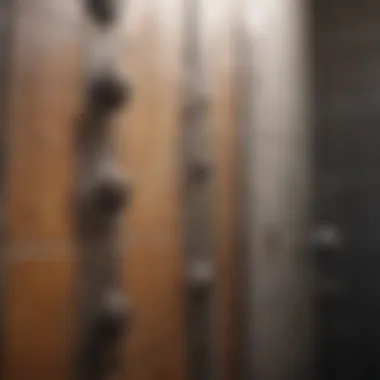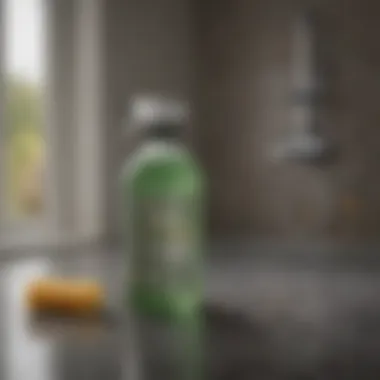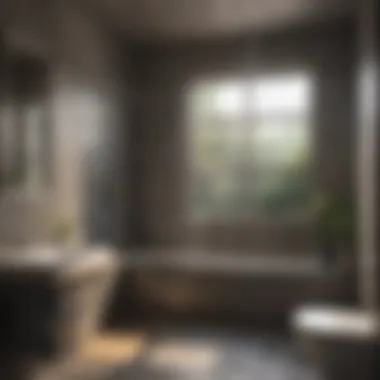Effective Strategies for Eliminating Shower Mold


Intro
Mold growth in showers is a common yet persistent problem that many homeowners face. It thrives in damp and humid environments, making bathrooms particularly susceptible. However, understanding the nature of mold and its causes lays the groundwork for effective solutions. This guide explores not just how to eliminate mold, but also how to prevent it from returning, thereby fostering a safer and more pleasant home environment.
In this discussion, essential strategies for combating mold will be addressed. These strategies include identifying mold types, effective cleaning methods, and the products best suited for maintenance. Additionally, maintaining a mold-free shower can improve your overall well-being, as mold spores can lead to various health issues. With these insights, homeowners can take informed action against mold proliferation.
Design Inspiration
While the elimination of mold is the primary focus, understanding the aesthetic context of your shower space can enhance the effectiveness of your mold prevention efforts. A well-designed area not only looks appealing but can also contribute to better hygiene.
Trending Styles
Design choices can influence moisture levels in the bathroom, which affects mold growth. Opting for sleek, modern designs with fewer nooks and crannies can minimize water retention. Consider materials like glass and porcelain, which are less porous than traditional tiles. They permit easier cleaning and resist mold accumulation more effectively. Trending styles often incorporate large, smooth surfaces that reduce the likelihood of mold spores taking hold.
Color Palettes
Choosing light, airy color palettes for your shower can help you spot early signs of mold growth. Lighter colors can make mold stains more visible, encouraging prompt cleaning. White, pastels, or soft neutrals are practical choices that provide a clean aesthetic and help in monitoring shower surface cleanliness.
Practical Tips
To effectively combat mold, practical measures need to be integrated into your bathroom routine. These tips will address maintenance and financial considerations to help you remain mold-free.
Maintenance & Care
Regular and thorough cleaning of your shower is essential. Consider the following maintenance tips:
- Use a squeegee after each shower to prevent excess moisture from accumulating.
- Clean with vinegar or a dedicated mold removal solution weekly to hinder growth about the cleaning routine.
- Ensure proper ventilation by using an exhaust fan or leaving a window open to reduce humidity levels.
Budgeting & Planning
Investing in quality mold inhibitors and cleaners may seem like a higher upfront cost, but it pays off by reducing health risks and extensive remediation later. Include mold-resistant products in your budget to maintain a safe shower environment. Consider products like Caulk and sealants specifically designed to resist mold growth. Additionally, envisioning your long-term plan on bathroom use can shape your purchasing decisions and routine.
To maintain a mold-free environment, regular maintenance combined with thoughtful design changes can significantly enhance the longevity of your bathroom space.
By recognizing mold's growth conditions and implementing preventative and corrective measures, homeowners can ensure a cleaner and safer shower.
For further reading, visit Wikipedia or Britannica.
For community discussions, check out relevant threads on Reddit.
Understanding Shower Mold Growth
Understanding how mold grows in showers is crucial for effective removal and prevention. Mold growth presents not only visually unappealing situations, but it also poses health risks. In addressing this problem, recognizing the conditions that lead to mold proliferation can empower homeowners. Mold thrives in specific environments, which we will explore in detail. This understanding benefits everyone looking to maintain a clean and healthy living space.
What is Shower Mold?
Shower mold refers to the fungal growth that commonly appears in damp areas of the bathroom. Mold spores are naturally present in the environment and can easily settle in humid, warm regions such as the shower. The most common types include black mold, green mold, and pink mold. Each kind has different characteristics. Black mold, for instance, is particularly hazardous to health. Knowing the identity of these molds is important for targeted action in removal and prevention.
Conditions Favoring Mold Proliferation
Humidity Levels
Humidity levels play a significant role in mold growth. Showers, by their nature, generate high humidity due to steam and water. The ideal humidity level for mold growth is above 60%. This condition allows mold spores to thrive. It is a critical factor that homeowners must monitor. The higher the humidity, the greater the risk of mold. Homeowners can mitigate this by ensuring their bathrooms remain dry and utilizing dehumidifiers if necessary.
Temperature Ranges
Temperature is another key aspect. Mold prefers warmer temperatures, typically between 77°F and 86°F. Within this range, it can grow rapidly. Showers often remain warm after use, providing an ideal breeding ground for these fungi. Keeping surfaces cooler through proper ventilation can help discourage mold growth.
Lack of Ventilation
Lack of ventilation is a significant contributor to shower mold issues. When airflow is restricted, moisture remains trapped in the bathroom. This stagnant air allows mold spores to settle and grow. Proper ventilation, such as exhaust fans, is essential. It helps to remove excess humidity after showering, creating a less conducive environment for mold proliferation.
Health Risks Associated with Mold


Health risks associated with mold exposure must not be overlooked. Understanding how mold affects health can motivate proactive measures against its growth.
Allergic Reactions
Allergic reactions to mold can vary in severity. Symptoms include sneezing, runny nose, and irritation of the eyes. Individuals with mold allergies may react even in small amounts. This is an essential aspect as it emphasizes why limiting mold growth is beneficial. Recognizing these symptoms can aid in quick responses to mold presence.
Respiratory Issues
Mold can exacerbate respiratory problems, especially in those with pre-existing conditions such as asthma. Breathing in mold spores can cause coughing, wheezing, and shortness of breath. This makes it a significant concern for the health of occupants in a home.
Long-Term Chronic Conditions
Long-term exposure to mold has the potential to lead to chronic health conditions. This can include persistent allergies or respiratory illnesses. For vulnerable individuals, such as children, the elderly, or anyone with compromised immunity, addressing mold growth is essential for maintaining health and well-being. Understanding these long-term risks can further underscore the importance of effective mold management strategies in the home.
Identifying Mold Issues in the Shower
Mold in the shower is more than just an unsightly problem; it indicates underlying moisture issues that can affect your health and the integrity of your home. Early detection is key in managing mold growth and preventing larger issues down the line. In this section, we will focus on how to identify mold issues effectively. Understanding the signs of mold can allow homeowners to act swiftly, preserving the health of their living space and avoiding costly remediation later.
Visual Signs of Mold
The most obvious sign of mold is, naturally, its visual presence. Mold can appear in various forms on shower walls, tiles, and grout. Common colors include black, green, and pink.
- Spotting Patterns: Mold generally appears in patches or spots, often in areas where water collects, such as corners or around fixtures.
- Texture Changes: Sometimes, mold may create a fuzzy or slimy texture on surfaces.
- Surface Discoloration: Noticeable discoloration of tiles or grout is a reliable indicator that mold may have set in.
Recognizing these visual clues is the first step in a mold management strategy.
Odors Indicative of Mold Growth
Mold also tends to produce distinct musty odors. If you notice a persistent, earthy smell in your shower space, it could signal mold growth even if it is not immediately visible. This odor generally arises from the natural process of mold breaking down organic materials.
- Unpleasant Smells: Foul smells in the bathroom that do not dissipate may suggest mold hiding in areas like caulking or behind tiles.
- Odor Strength: The intensity of the smell can indicate how extensive the mold problem might be. Stronger odors typically correlate with larger mold colonies.
Being vigilant about strange smells in your bathroom could lead to earlier detection and remedying of mold issues.
Different Types of Shower Mold
Mold in the shower is not uniform; it can vary in color and type. Each type of mold has unique characteristics and implications. Recognizing these differences can guide homeowners in addressing the specific mold problem more effectively.
Black Mold
Black mold, or Stachybotrys chartarum, is infamous for its health implications. Its dark color makes it easily distinguishable.
- Health Risks: Exposure can lead to respiratory problems and allergic reactions. Therefore, tackling black mold is crucial for health and safety.
- Unique Features: It thrives in damp areas and, unlike other molds, often requires a significant moisture source to grow extensively. So, if you spot it, immediate action is needed.
Green Mold
Green mold may be less threatening than black mold but should still not be ignored. It often appears fuzzy or velvety.
- Associated Conditions: It is commonly linked with damp environments but usually has less severe health effects. However, certain strains can still pose risks, particularly for those with allergies.
- Common Occurrence: You often find green mold in showers as it thrives in warm, moist locations.
Pink Mold
Pink mold, while technically not mold but a form of bacteria known as Serratia marcescens, is another problem to be aware of.
- Characteristic Traits: It appears as a pink or reddish layer and often develops in damp areas that do not get enough sunlight.
- Concerns: While generally not harmful, it can contribute to respiratory issues in sensitive individuals.
Effective Mold Removal Techniques
Effective mold removal techniques are vital in maintaining a healthy and pleasant shower environment. Mold not only affects the aesthetics of your shower, but it can pose health risks as well. Therefore, understanding and applying the right methods to remove it becomes critical. This section will explore various techniques, highlighting their benefits, considerations, and effectiveness in addressing mold issues.
Household Remedies for Mold Removal
Household remedies can offer an economical and environmentally friendly approach to mold removal. Many common household products can effectively combat mold without the need for harsh chemicals.


Baking Soda and Vinegar
Baking soda and vinegar is a popular combination. It works well due to its mild antibacterial properties and effectiveness in breaking down mold. When mixed, the effervescent reaction creates a powerful cleaning agent. This remedy leaves no strong odors, making it suitable for indoor use.
The advantages of this combination include its safety for most surfaces and its non-toxic nature. However, the main downside is that it may not be as effective on large infestations. Regular maintenance can prevent heavy mold buildup quite well.
Hydrogen Peroxide
Hydrogen peroxide is another effective solution. It acts as a bleaching agent and has antifungal properties, making it suitable for mold removal. This compound can destroy mold spores on various surfaces.
Its key characteristic is that it is less harsh than some commercial cleaners, making it a beneficial choice for more sensitive areas. While this product works efficiently, it can discolor some materials if left too long, which is a consideration to keep in mind.
Essential Oils
Essential oils, such as tea tree or lavender oil, are becoming increasingly popular for mold removal. They have natural antifungal properties, which make them effective in combating mold growth. Using essential oils adds pleasant scents to your cleaning routine as a bonus.
The primary advantage is their gentle nature and effectiveness against smaller patches of mold. However, they may not be suitable for larger infestations and their cost can add up if used frequently.
Commercial Cleaning Products
When household remedies are not sufficient, commercial cleaning products become necessary. These products are often formulated specifically to tackle mold and mildew, offering stronger solutions than typical household items.
Mold and Mildew Removers
Mold and mildew removers are highly effective for tougher mold cases. They contain powerful chemicals designed to eradicate mold quickly and efficiently.
Their key characteristic is that they provide immediate results, often requiring minimal scrubbing. However, they can emit strong odors and may be harsh on some surfaces. Proper ventilation is required when using these products.
Disinfectants
Disinfectants that contain bleach or other strong chemicals help remove and prevent mold growth. These products kill mold spores effectively and help sanitize surfaces.
One notable feature is their dual action of disinfecting while removing mold. They tend to be effective even in hidden or hard-to-reach areas. However, their harshness could damage certain materials, making it important to test in a small area first.
Step-by-Step Cleaning Process
Following a structured cleaning process is crucial for effectiveness. This often entails:
- Preparation: Gather necessary cleaning supplies and protective gear such as gloves and masks to ensure safety.
- Initial cleaning: Remove any loose debris or moisture from the affected area.
- Application: Apply the chosen remedy or product directly to affected areas.
- Scrubbing: Use a scrub brush to gently remove mold from surfaces.
- Rinsing: Rinse the area thoroughly to remove any remaining residue.
- Drying: Allow surfaces to dry completely to prevent mold from returning.
Implementing these techniques can greatly improve your chances of eliminating mold effectively in your shower.
Preventing Future Mold Growth
Preventing future mold growth is vital for maintaining a clean and healthy shower environment. Mold not only damages surfaces but also poses health risks. By actively taking measures to prevent its growth, homeowners can ensure that their showers remain in good condition and free from harmful spores. This section explores practical elements, benefits, and considerations related to the prevention of mold in shower spaces.
Best Practices for Shower Maintenance
Regular Cleaning Schedule
A regular cleaning schedule is fundamental to mold prevention. Consistency helps remove soap scum and moisture that serve as food for mold. This practice emphasizes the importance of cleaning often, which can be a beneficial approach for any household. A well-planned frequency for cleaning can lead to a noticeable reduction in mold occurrence.
The unique feature of a regular cleaning schedule is traceability. Homeowners can track whether their efforts are yielding results over time. On the other hand, it requires commitment. Creating a mess can quickly happen when cleaning is neglected. Therefore, establishing this routine is essential in making a positive impact.
Post-Shower Practices
Post-shower practices refer to the actions taken immediately after using the shower. This aspect plays a significant role in reducing moisture levels, which directly impacts mold growth. For example, leaving the shower door open or using a squeegee to dry surfaces can be effective. These practices are popular among homeowners seeking to protect their living environment.
The key characteristic of post-shower practices lies in immediacy. Acting right away can lead to more effective moisture management. However, it requires mindfulness; the success of these practices depends on consistent effort from everyone who uses the shower.
Enhancing Shower Ventilation
Installing Exhaust Fans


Installing exhaust fans in a bathroom is a powerful method to enhance ventilation. These fans effectively remove humidity and improve air circulation, minimizing the conditions mold needs to thrive. This is a highly recommended choice for maintaining a dry shower environment.
The unique feature of exhaust fans is their capability to manage moisture quickly. They can significantly decrease humidity levels within minutes. However, one disadvantage may include installation costs. Homeowners must weigh the expense against potential future mold issues.
Utilizing Open Windows
Utilizing open windows is another practical method for improving ventilation in the shower area. This strategy is simple and cost-effective. Fresh air can circulate, lowering humidity and reducing the probability of mold growth.
The key characteristic of this method is accessibility. Most people have windows in their bathrooms which can be opened quickly. However, this approach is dependent on weather conditions, making it less reliable during heavy rain or freezing temperatures.
Using Mold-Resistant Materials
Paints and Sealants
Choosing mold-resistant paints and sealants offers a proactive solution against mold. These materials are designed to inhibit mold growth, making them a wise choice for areas that experience regular moisture. Their application helps protect surfaces and maintain the aesthetic integrity of the shower.
The unique feature of these paints and sealants is their longevity. They provide lasting protection, reducing maintenance efforts. Although they might be more expensive upfront, their durability can save money in the long run by preventing mold-related damages.
Shower Liners and Curtains
Incorporating mold-resistant shower liners and curtains into bathroom design is another effective layer of protection. These materials are typically treated to resist mold and can be easily replaced. They contribute significantly to the overall goal of a cleaner shower environment.
The main advantage of this method is ease of installation. Homeowners can easily swap out standard liners for mold-resistant ones with little effort. However, over time, even these materials can accumulate moisture if not cared for properly. Regular washing is still necessary to maintain their effectiveness.
Assessing Long-Term Solutions
Assessing long-term solutions to mold problems goes beyond mere removal. It is crucial for maintaining a sustainable, mold-free environment in your shower. Ignoring underlying issues during cleanup can lead to recurring mold growth, which not only affects the appearance of your space but can also pose health risks to you and your family.
A well-thought-out plan can ensure that mold does not make a return. This involves considering design modifications, utilizing professional services, and implementing consistent monitoring strategies. These solutions can be tailored to individual homeowner needs, supporting both aesthetic desires and health requirements.
Redesigning Shower Areas
Shower redesign is a powerful approach to mitigate mold. Updating tiles to those that are mold-resistant or replacing a shower curtain with a liner can create an unfriendly habitat for mold growth. The choice of materials plays a key role.
Here are some elements to consider when redesigning:
- Opt for non-porous surfaces like glass or acrylic that do not retain moisture.
- Choose lighter colors for fixtures and tiles as they tend to show stains more prominently, prompting timely cleaning.
- Ensure that all corners and nooks are easily accessible during cleaning sessions.
All these choices contribute to reducing the conditions that encourage mold to flourish.
Hiring Professional Services
For more severe mold issues or persistent problems, hiring professional services may be necessary. This involves seeking experts specifically in mold inspection and remediation. They offer comprehensive solutions tailored to your situation, ensuring thorough assessments and clean-ups.
Mold Inspection Professionals
Mold inspection professionals offer crucial evaluations of your shower area, identifying hidden mold and moisture sources. Their expertise allows them to pinpoint potential risk areas that homeowners might overlook.
A key characteristic of these professionals is their use of advanced techniques such as thermal imaging and moisture meters. This enhances their ability to detect moisture buildup in less visible spaces.
Engaging professionals ensures that mold's underlying causes are effectively managed, making it a beneficial choice for homeowners dealing with recurrent mold episodes.
Remediation Services
Remediation services go a step further by providing solutions to remove identified mold and prevent new growth. Their work is comprehensive, involving containment, cleanup, and repairing damage caused by mold.
One advantage of these services is their thorough approach, often employing specialized cleaning agents that are not available for general consumers. However, the potential downside can be the expense involved, which some homeowners might find daunting.
Despite the costs, investing in professional remediation can save homeowners from costly repairs resulting from prolonged mold exposure.
Monitoring and Ongoing Maintenance
Establishing a system for monitoring and ongoing maintenance is vital for preserving your mold-free environment. Regular checks can catch moisture early, preventing long-term mold development.
Effective strategies include:
- Scheduling quarterly inspections, especially in high-risk areas.
- Keeping track of environmental conditions, like humidity levels.
- Regularly cleaning shower spaces with appropriate solutions to eliminate spores before they develop into mold.
Incorporating these practices builds a sustainable barrier against mold in your shower, allowing for a pleasant and healthy bathing experience.















